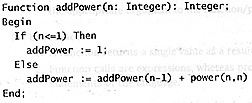| 1. |
(a) Briefly explain the following
terms: |
|
|
|
(i) recursive procedure3 |
[2] |
|
|
|
a recursive procedure
will contain a call to itself within the body of the procedure. |
|
|
|
|
some form of selection
will be used to determine when to recursively call the procedure. |
|
|
|
|
any example of a
recursive procedure. |
|
|
|
|
1 mark for each of the
points above, to a maximum of 2 marks. |
|
|
|
[2
marks] |
|
|
|
(ii) queue |
[2] |
|
|
|
an example of an
abstract data type. |
|
|
|
|
supports FIFO
(First-in, First-out) processing. |
|
|
|
|
contains at least two
operations, enqueue and dequeue, to insert and remove elements from the queue. |
|
|
|
|
1 mark for each of the
points above, to a maximum of 2 marks. |
|
|
|
[2
marks] |
|
|
|
(iii) abstraction |
[2] |
|
|
abstraction:
the physical properties of an item (how it works) |
[1] |
|
|
are
separated from its logical properties (how it is used). |
[1] |
|
|
[2
marks] |
|
|
|
(iv) black box testing |
[2] |
|
|
|
testing a
module/program without any knowledge of the logic of the program. |
[1] |
|
|
|
tests to see if the
right outputs are achieved using the inputs provided. |
[1] |
|
|
[2
marks] |
|
|
|
(v) binary search |
[2] |
|
|
a search
procedure that splits the search space into two parts, |
[1] |
|
|
and
searches one or both of the resultant parts, depending upon the application, using the
same, recursive, procedure. |
[1] |
|
|
[2
marks] |
|
|
|
|
|
(b) Write a Pascal type definition
that models the following data-structure: |
[3] |
|

|
|
|
Declaration
of the tree type as follows. |
|
|

 |
|
|
The student
should not be penalised for using different names for Data, Left, Right, Up, Down,
Pointer, NodeType, or Pointer. |
|
|
[3
marks] |
|
|
|
|
|
(c) Pascal does not contain a
power operator (i.e., xy). Write a function power that takes two parameters x
and y and calculate xy. You need not use recursion in the definition of power. |
[3] |
|
A
recursive definition of power is shown below: |
|
|
 |
|
|
and the
following marking scheme should be used: |
|
|
|
one mark for
identifying the base case correctly. i.e., return 1 when y is less than 1. No marks should
be deducted if the students just identify the conditional for the base case as y=0. |
|
|
|
one mark for
the term x* in the expression that is part of the recursive case of the function
definition. |
|
|
|
one mark for
identifying the correct recursive call power (x, y - 1) |
|
|
|
no marks
should be deducted for trivial syntactic errors. |
|
|
Alternatively,
the students may use iteration in a definition as follows: |
|
|

 |
|
|
and the
following marking scheme should be used: |
|
|
|
one mark for
identifying that the variable that holds the result of the function should be initialised
to 1. |
|
|
|
one mark for
the definition of a for - do statement that contains y iterations. |
|
|
|
one mark for
changing the value of the result variable power by multiplying by x. |
|
|
[3
marks] |
|
|
|
|
|
(d) Use the function power in the
definition of a recursive function addPower that takes a single positive
integer value n as a parameter, and returns an integer that is the sum of the
following series: |
[4] |
|
|
f(n) = 11
+ 22 + 33 + . . . + nn |
|
|
A
recursive definition of the addPower function is shown below: |
|
|
 |
|
|
Four marks
should be awarded for the definition as follows: |
|
|
|
one mark for a
correct function definition. i.e., identifying that addPower takes an integer parameter n
and returns an integer as a result. No marks should be deducted if the Procedure keyword
is used in preference to Function, as long as a return type is given. |
|
|
|
one mark for
identifying a correct base case for the recursion. i.e., one is returned from the function
when n is less than or equal to one. |
|
|
|
one mark for
identifying that the power function power (n, n) is required at each iteration of the
recursion. |
|
|
|
one mark for
the recursive case of calling addPower (n - 1). |
|
|
|
no marks
should be deducted for trivial syntactic errors (i.e., missing semi-colons; using =
instead of := in an assignment; missing Begin/End statements). No marks should be deducted
if the recursive case contains a statement of the form: addPower := power (n, n) +
addPower(n - 1); |
|
|
[4
marks] |
|





